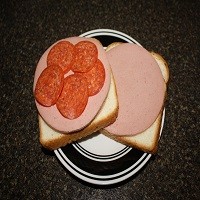Lose Weight > Weight Loss Tips > Weight Loss Articles > How I Lost 30 Pounds In Two And A Half Months
How I Lost 30 Pounds In Two And A Half Months
Losing weight is something you hear people talk about all the time. Some people are successful at it, while others fail miserably. The road to success varies from one person to the next -- some choose to strictly diet, while others combine exercise with better eating habits. The road to failure, I believe, has a common theme for most people -- lack of commitment and perseverance.
I am not a doctor, psychologist, dietitian, fitness guru, or personal trainer, nor have I written any books about weight loss. I am a computer software engineer who weighed 210 pounds in late December of 2010, and decided, at age 51, that I needed to make a change. My goal was to lose 30 pounds. The time-frame was not important, although two months was always in the back of my mind.
For the first week of January, I simply changed my eating habits. These changes were based on a couple of articles I read on the Internet that described what foods to eat, and what foods to avoid. Most of what I read was just common sense, or at the very least, information that I had absorbed over the years from visits to the doctor, commercials on TV, word-of-mouth, etc. And the same key phrases seem to persist in all of this information: low in fat, low in carbohydrates, low in sodium, low in calories, high in fiber, high in protein. Throughout this whole process, I never kept track of the number of calories I consumed each day. I was always calorie aware, however, always scanning the nutritional information for any food that I bought.
So how did my diet change? Let me start with what I eliminated from my diet. To begin with, I stopped drinking beer. Most beer is high in calories (about 120 calories per bottle) and has a tendency to make you feel very hungry, leading to the inevitable late night snack. As a rule, I never ate anything after 8:00pm. I also eliminated all junk food -- potato chips, hamburgers, hot dogs, French fries, onion rings, nachos, and Dewey platters (these platters are served at a local restaurant and consist of chicken wings, zucchini sticks, potato skins, and nachos - not a healthy selection to say the least). Finally, I eliminated white bread and pasta, and reduced my consumption of potatoes and meats such as pork and beef. On the odd occasion that I did choose to eat pork or beef (about two or three times in two and a half months), it was always lean cuts such as pork tenderloin or beef tenderloin.
With the junk food eliminated, I started making healthier choices. Breakfast normally consisted of high-fiber cereal (such as Fiber One), a high-fiber cereal bar, and either low-fat yogurt or a small bowl of fruit.
Lunch consisted of a salad, a hearty bowl of soup, or a sandwich on multi-grain bread, usually tuna fish or deli oven-roasted turkey, with a side of carrots, celery, or both (no chips or pretzels).
Dinner consisted of either skinless chicken, fish, or ham, vegetables (broccoli, cauliflower, asparagus, red and green peppers, and carrots were frequent choices), and rice or a small salad. For rice, my choice was sticky rice, not wild rice, which I believe is recommended by most diets. Oh well, maybe I dropped the ball on this one, but I kept the portion small. A stir fry using olive oil was a weekly favorite, consisting of chicken and vegetables, or shrimp and vegetables.
If I decided not to have vegetables for dinner, I would usually drink a vegetable cocktail (such as V8). And quite frequently, I would have hot peppers, such as banana peppers or jalapeno's, either on my sandwich at lunch, or as a side dish for dinner. Apparently, hot peppers help to increase your metabolism.
For snacks, I would eat carrot sticks, a piece of fruit, or nuts (usually almonds). Nuts were particularly good, since a small amount would give me a the feeling of being full. Finally, I drank lots of water -- at least two liters a day.
After the first week of January, I decided to buy some exercise equipment and weights. My days of playing hockey are behind me, so I wasn't getting regular exercise, and regular exercise burns calories. I chose to purchase an elliptical trainer and a stationary bicycle. A stationary bicycle is an exercise machine that resembles a bicycle, with pedals, a saddle, and some form of handle bars, but that remains in a fixed (stationary) position when used. An elliptical trainer is a stationary exercise machine used to simulate stair climbing, walking, or running without causing excessive pressure to the joints.
I started out riding the stationary bicycle for 30 minutes every day. Depending on the program (there were ten programs with varying degree of difficulty), I was pedaling approximately 7 kilometers and burning anywhere from 200 to 250 calories. To put this in perspective, one pound of fat is equivalent to about 3500 calories. So if you eat an extra 350 calories every day, you will gain a pound every 10 days. Assuming a burn rate of 250 calories per 30 minute session on the bike, I would require 8 sessions on the bike to burn one pound of fat (that's 4 hours and 56 kilometers).
A stationary bicycle was always my first choice for exercising, but after trying the elliptical trainer a couple of times, I found I could burn twice as many calories using certain programs. So after approximately two weeks, I started using the elliptical trainer on a daily basis for 30 minutes. The program I chose varied the resistance from start to finish -- similar to riding a bicycle in the mountains, I guess -- allowing me to burn about 500 calories. I found the elliptical trainer provided a more complete work out, capable of exercising both the upper and lower body.
After approximately three weeks, I purchased dumb-bells and a bench, and added light weight training to my exercise routine. Increasing muscle mass increases your metabolism and helps to burn calories.
After two and half months of daily exercise and better eating habits, I reached my target weight of 180 lbs., having lost a total of 30 lbs. I'm back enjoying a cold beer along with a strip-loin or hamburger on the barbecue every now and again, but my game plan remains the same. The only difference is that I've switched to maintenance mode, with a target weight gain of 0 lbs.
Losing weight and keeping it off doesn't necessarily mean a complete change of lifestyle. What it does mean is establishing good habits, like exercising daily and eating properly.
I am not a doctor, psychologist, dietitian, fitness guru, or personal trainer, nor have I written any books about weight loss. I am a computer software engineer who weighed 210 pounds in late December of 2010, and decided, at age 51, that I needed to make a change. My goal was to lose 30 pounds. The time-frame was not important, although two months was always in the back of my mind.
For the first week of January, I simply changed my eating habits. These changes were based on a couple of articles I read on the Internet that described what foods to eat, and what foods to avoid. Most of what I read was just common sense, or at the very least, information that I had absorbed over the years from visits to the doctor, commercials on TV, word-of-mouth, etc. And the same key phrases seem to persist in all of this information: low in fat, low in carbohydrates, low in sodium, low in calories, high in fiber, high in protein. Throughout this whole process, I never kept track of the number of calories I consumed each day. I was always calorie aware, however, always scanning the nutritional information for any food that I bought.
So how did my diet change? Let me start with what I eliminated from my diet. To begin with, I stopped drinking beer. Most beer is high in calories (about 120 calories per bottle) and has a tendency to make you feel very hungry, leading to the inevitable late night snack. As a rule, I never ate anything after 8:00pm. I also eliminated all junk food -- potato chips, hamburgers, hot dogs, French fries, onion rings, nachos, and Dewey platters (these platters are served at a local restaurant and consist of chicken wings, zucchini sticks, potato skins, and nachos - not a healthy selection to say the least). Finally, I eliminated white bread and pasta, and reduced my consumption of potatoes and meats such as pork and beef. On the odd occasion that I did choose to eat pork or beef (about two or three times in two and a half months), it was always lean cuts such as pork tenderloin or beef tenderloin.
With the junk food eliminated, I started making healthier choices. Breakfast normally consisted of high-fiber cereal (such as Fiber One), a high-fiber cereal bar, and either low-fat yogurt or a small bowl of fruit.
Lunch consisted of a salad, a hearty bowl of soup, or a sandwich on multi-grain bread, usually tuna fish or deli oven-roasted turkey, with a side of carrots, celery, or both (no chips or pretzels).
Dinner consisted of either skinless chicken, fish, or ham, vegetables (broccoli, cauliflower, asparagus, red and green peppers, and carrots were frequent choices), and rice or a small salad. For rice, my choice was sticky rice, not wild rice, which I believe is recommended by most diets. Oh well, maybe I dropped the ball on this one, but I kept the portion small. A stir fry using olive oil was a weekly favorite, consisting of chicken and vegetables, or shrimp and vegetables.
If I decided not to have vegetables for dinner, I would usually drink a vegetable cocktail (such as V8). And quite frequently, I would have hot peppers, such as banana peppers or jalapeno's, either on my sandwich at lunch, or as a side dish for dinner. Apparently, hot peppers help to increase your metabolism.
For snacks, I would eat carrot sticks, a piece of fruit, or nuts (usually almonds). Nuts were particularly good, since a small amount would give me a the feeling of being full. Finally, I drank lots of water -- at least two liters a day.
After the first week of January, I decided to buy some exercise equipment and weights. My days of playing hockey are behind me, so I wasn't getting regular exercise, and regular exercise burns calories. I chose to purchase an elliptical trainer and a stationary bicycle. A stationary bicycle is an exercise machine that resembles a bicycle, with pedals, a saddle, and some form of handle bars, but that remains in a fixed (stationary) position when used. An elliptical trainer is a stationary exercise machine used to simulate stair climbing, walking, or running without causing excessive pressure to the joints.
I started out riding the stationary bicycle for 30 minutes every day. Depending on the program (there were ten programs with varying degree of difficulty), I was pedaling approximately 7 kilometers and burning anywhere from 200 to 250 calories. To put this in perspective, one pound of fat is equivalent to about 3500 calories. So if you eat an extra 350 calories every day, you will gain a pound every 10 days. Assuming a burn rate of 250 calories per 30 minute session on the bike, I would require 8 sessions on the bike to burn one pound of fat (that's 4 hours and 56 kilometers).
A stationary bicycle was always my first choice for exercising, but after trying the elliptical trainer a couple of times, I found I could burn twice as many calories using certain programs. So after approximately two weeks, I started using the elliptical trainer on a daily basis for 30 minutes. The program I chose varied the resistance from start to finish -- similar to riding a bicycle in the mountains, I guess -- allowing me to burn about 500 calories. I found the elliptical trainer provided a more complete work out, capable of exercising both the upper and lower body.
After approximately three weeks, I purchased dumb-bells and a bench, and added light weight training to my exercise routine. Increasing muscle mass increases your metabolism and helps to burn calories.
After two and half months of daily exercise and better eating habits, I reached my target weight of 180 lbs., having lost a total of 30 lbs. I'm back enjoying a cold beer along with a strip-loin or hamburger on the barbecue every now and again, but my game plan remains the same. The only difference is that I've switched to maintenance mode, with a target weight gain of 0 lbs.
Losing weight and keeping it off doesn't necessarily mean a complete change of lifestyle. What it does mean is establishing good habits, like exercising daily and eating properly.
Related Articles
-
Weight Loss is Easier with Hypnosis
Weight loss and hypnosis燼re considered爐he factors to become
-
How Much Calories Should You Eat Per Day?
You will understand how the body works and reacts. This can burn calo
-
Lose Weight In A Week, The Easy Way!
When my clients tell me they want to lose weight in a week, I gener
-
Try These Easy Weight Loss Tips
Whether you have a little or a lot of weight to lose, it can seem daun
-
HCG drops for weight loss
HCG drop is one of the best ways to induce HCG into your diet. If y
-
Four ways to lose weight this summer
hurray, Summer is right around the corner! The sun will be shining, th
- DON'T MISS
- Apidexin Diet Pill Reviews - Is Apidexin the Best Weight Loss Pill?
- Which contain chemical material but meizitang botanical slimming soft gel
- Use the Power of Yoga to Stay Healthy
- Change What You Crave By Changing How You Think: The 5 Step Mental Method
- Weight Loss Exercise Tips: Using the Best Cardio Machines
- Diet Meals To Your Door
- Hoodia, Fat and Calories - The Unique Weight Loss Connection
- The Diet Solution Program - Lose Weight Naturally
- How Much Fat Can You Lose In A Week - Best Online Weight Loss
- 100 Sit Ups A Day to Get A Six Pack?




